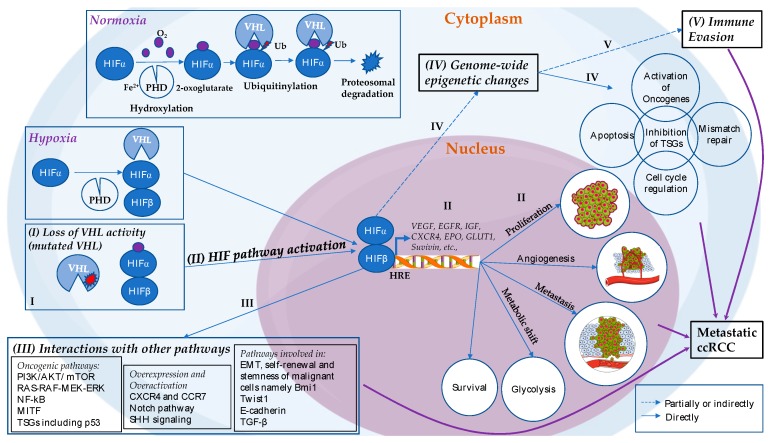Figure 1.
Physiology of the VHL-HIF pathway along with proposed etiopathogenesis that leads to metastatic ccRCC. In normoxia, HIFα hydroxylation is carried out by PHDs that requires iron, ascorbate and 2-oxoglutarate. PHD proteins use oxygen to add hydroxyl group on one of two conserved proline residues in the Oxygen Degradation Domain of the α-subunit of the HIFα molecule in order to mark it for recognition by pVHL. pVHL then recognizes hydroxylated HIFα, ubiquitinylates it and targets it for proteasomal degradation. However, in hypoxia, hydroxylation step by PHDs does not happen, resulting in HIFα stabilization. HIFα accumulates in the cytoplasm, forms complex with constitutionally expressed HIFβ, and eventually translocates into the nucleus where is binds to HREs, thereby activating hundreds of genes related to adaptation to a low oxygen environment. (I) Loss of VHL activity; (II) Constitutively active HIF pathway: When the VHL is mutated, pVHL is non-functional, resulting in stabilization of HIFα, and downstream overexpression of numerous genes involved in angiogenesis (e.g., VEGFA), proliferation (e.g., EGFR), cell migration and invasion (e.g., CXCR4), metabolic shift towards glycolysis (e.g., GLUT1), survival (e.g., survivin), erythropoiesis (e.g., EPO), which ultimately contribute to ccRCC tumorigenesis; (III) Interaction of the HIF pathway with other pathways: While HIF pathway interacts with and enhances the activity of other oncogenic pathways, it may also contribute to the genome-wide epigenetic alterations; (IV) Genome-wide epigenetic alterations: The epigenome patterns, established also due to mutations of multiple TSGs involved in epigenetic modifications, alter various oncogenic, apoptotic, cell cycle regulatory and mismatch repair pathways; and (V) Immune evasion: Lastly, immune evasion occurs in ccRCC which is suggested to be partially enhanced by genome-wide epigenetic alterations. All these interactions and mechanisms interplay throughout the pathogenesis and carcinogenesis of the metastatic ccRCC [42]. Abbreviations: VHL, von Hippel Lindau; HIF, hypoxia inducible factor; PHD, prolyl hydroxylase; Ub, ubiquitin; HRE, hypoxia response elements; PI3K, phosphoinositide 3-kinase; mTOR, mammalian target of rapamycin; NF-κB, nuclear factor kappa B; MITF, microphthalmia-associated transcription factor; CXCR4, CXC chemokine receptor 4; CCR7, C-C chemokine receptor type 7; SHH, sonic hedgehog; TSGs, tumor suppressor genes, EMT, epithelial to mesenchymal transition; TGF-β, transforming growth factor beta; and ccRCC, clear cell renal cell carcinoma.

